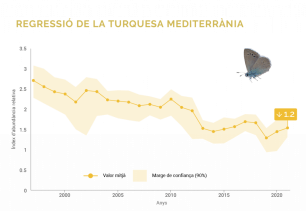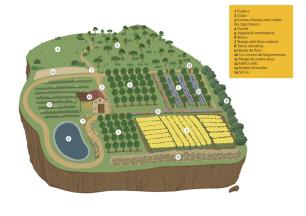
The report highlights the need for a monitoring programme for pollinator populations and the development of catalogues and distribution maps for the main groups (bees and syrphids), comparable with those already existing for butterflies.
The Director General of Environmental Policies and Natural Environment, Marc Vilahur, along with the Director General of Agriculture and Livestock, Elisenda Guillaumes, and the researcher and Doctor in Biology from CREAF, Jordi Bosch, have presented the report ‘Wild pollinators in Catalonia’. This is the first report of this kind to be produced in Catalonia which analyses the status, threats and priority areas of action for the conservation of pollinating insects.
The report, which has been prepared within the framework of the Observatori del Patrimoni Natural i la Biodiversitat, has been coordinated by the Department d’Acció Climàtica, Alimentació i Agenda Rural and CREAF. The Museu de Ciències Naturals de Granollers, the Universitat Autònoma de Barcelona and the Institut de Recerca i Tecnologies Agroalimentàries (IRTA) have also participated.
Of the more than 2,000 bee species in Europe, 9% are considered threatened and 37% are in decline.
The report notes that in Catalonia and throughout the world, over the last century, very significant declines have been detected in the diversity and abundance of pollinating insects, especially bees and butterflies, and to a lesser extent in hoverflies. Of the more than 2,000 bee species in Europe, 9% are considered threatened and 37% are in decline. In the case of diurnal butterflies, the European Red List estimates that 9% are threatened and 31% are in decline.
In Catalonia we have data on butterfly population trends over the last 30 years.
The Director of Environmental Policies and Natural Environment highlighted the importance of the study as a starting point for the development of the Inter-sectoral Plan for the Conservation of Wild Pollinators in Catalonia (PIPOL). ‘It is clear, as the study itself concludes, that in Catalonia and throughout the world there have been significant declines in the diversity and abundance of pollinating insects and, therefore, we must support measures to help reverse this situation,’ said Marc Vilahur.
In the same line, the Director General of Agriculture and Livestock said that ‘we must be able to maintain the functionality and productivity of agricultural ecosystems and promote measures such as the recovery of multifunctional margins, the reduction of pesticides and others that help us to raise awareness and favour the services and benefits provided by wild pollinators’.
Situation and diagnosis
There is ample evidence that populations of many insect species are experiencing population declines. This evidence increases rapidly as long time series of monitoring programmes accumulate. Thanks to data collected over more than 30 years by volunteers of the Catalan Butterfly Monitoring Scheme (CBMS) project, we know that declines have occurred in 70% of the butterfly species in Catalonia. Butterflies associated with meadows and grasslands have declined much more than those that prefer forest environments. The CBMS has also detected that 5% of the butterfly populations monitored in Catalonia have suffered local extinctions. There are 45 threatened species of diurnal butterflies, 12 of which are already ‘in danger of extinction’, 32 are ‘vulnerable’ and one is ‘extinct as a breeder in Catalonia’.

Regression of the Mediterranean turquoise (Glaucopysche melanops; Lycaenidae) in Catalonia in the period 1998-2021. Source: CBMS.
However, this decline does not affect all species equally. In the case of bees, the most affected species are those with large body size, those with long tongues and those with a high degree of specialisation, both in terms of habitat and diet.
As for the main factors driving the decline of pollinating insects, the report identifies loss and fragmentation of natural habitats, intensification of agriculture, urbanisation, closure of forest clearings and climate change as the main drivers. Intense land use change over the last decades has led to a decline in flowers that serve as food for pollinators and food plants for butterfly caterpillars. In this sense, it is necessary to recover the grasslands and multifunctional margins of the crop fields. Agricultural intensification means a loss of crop and habitat diversity in general, and increased use of harmful pesticides by pollinators. Climate change is altering insect life cycles and affecting the ranges of many pollinators, which are shifting to historically cooler areas. Climate change is also negatively affecting flower production and nectar secretion.
A strategy to combat pollinator decline
The report presented today will serve as the basis for a strategic plan to combat the decline in pollinator populations. The Inter-sectoral Plan for the conservation of wild pollinators in Catalonia (PIPOL), provided for in the Natural Heritage and Biodiversity Strategy of Catalonia 2030 and aligned with the EU Pollinator Initiative, will be drafted during 2023 in collaboration with the most relevant sectors for the conservation of pollinators.

The instrument aims to respond to the widespread decline of these insects and to ensure the ecosystem service of pollination they provide through a range of actions to restore pollinator habitats in agricultural, forest and peri-urban landscapes, reduce the impact of plant protection products, and raise awareness of the services and benefits provided by wild pollinators and their links to food security.
‘This study is the prelude to a plan that must go beyond the analysis of the situation and that must point the way to promote concrete actions and measures agreed with all the sectors involved that will help us to reverse this situation,’ said Marc Vilahur.

